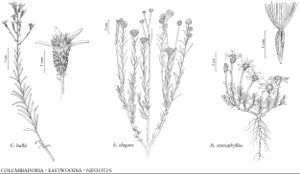Eastwoodia
Zoë 4: 397. 1894.
| Taxon | Illustrator ⠉ | |
|---|---|---|
 | Columbiadoria hallii Eastwoodia elegans Nestotus stenophyllus | Linny Heagy Barbara Alongi Yevonn Wilson-Ramsey |
Shrubs, rounded, 30–100 cm. Stems erect, branched, glabrous, often resinous. Leaves cauline; alternate; sessile; blades 1-nerved, linear to linear-oblanceolate, margins entire (apices acute), faces glabrous or sparsely hirtellous, gland-dotted (in pits), slightly resinous. Heads discoid, borne singly or in loosely corymbiform arrays. Involucres hemispheric to campanulate, impressed at base, 4–6 × 7–22 mm. Phyllaries 30–45 in 3–5 series, stiffly erect, green on distal 1/2, 1-nerved (midnerves indurate and raised; slightly convex, strongly keeled by midnerves), oblanceolate, unequal, thick, proximally indurate, margins narrowly scarious, (apices acute to apiculate) faces glabrous, resinous. Receptacles flat, pitted, paleate (paleae falling quickly, oblanceolate, chartaceous). Ray-florets 0. Disc-florets 30–40, bisexual, fertile; corollas yellow, tubes longer than cylindric to funnel-shaped throats, lobes 5, spreading to reflexing, narrowly lanceolate; style-branch appendages triangular-lanceolate. Cypselae (brownish) narrowly obconic, 3–4-angled, strigoso-sericeous (especially on angles); pappi persistent, of 5–8 linear-lanceolate, thick, flat, minutely erose scales in 1 series. x = 9.
Distribution
sw United States
Discussion
Species 1.
Eastwoodia is recognized by its white-barked, shrubby habit, linear, gland-dotted, resinous leaves, discoid heads on leafy stems, paleate receptacles, and pappi of long scales.
Selected References
None.
Lower Taxa
"thick" is not a number."thick" is not a number.